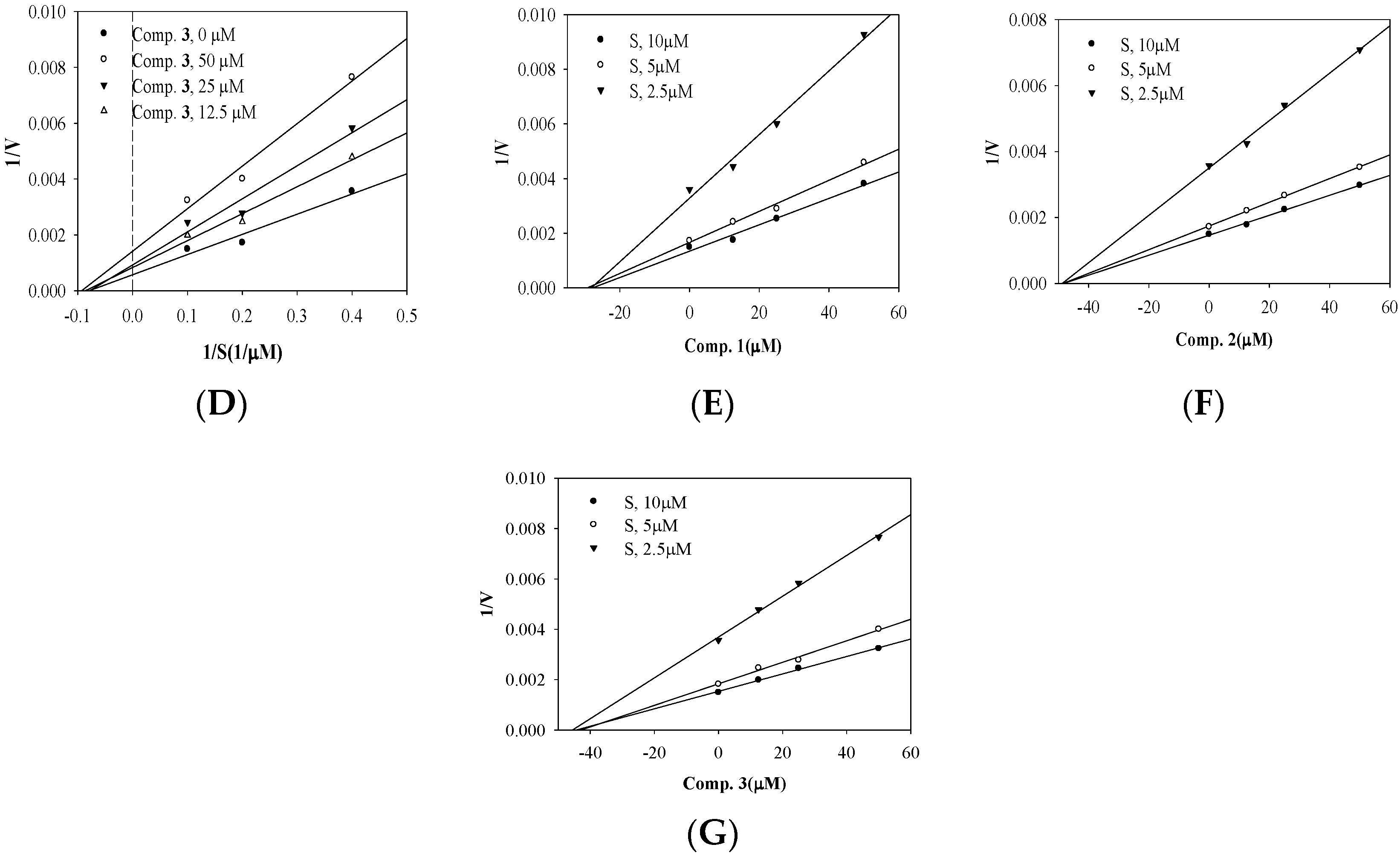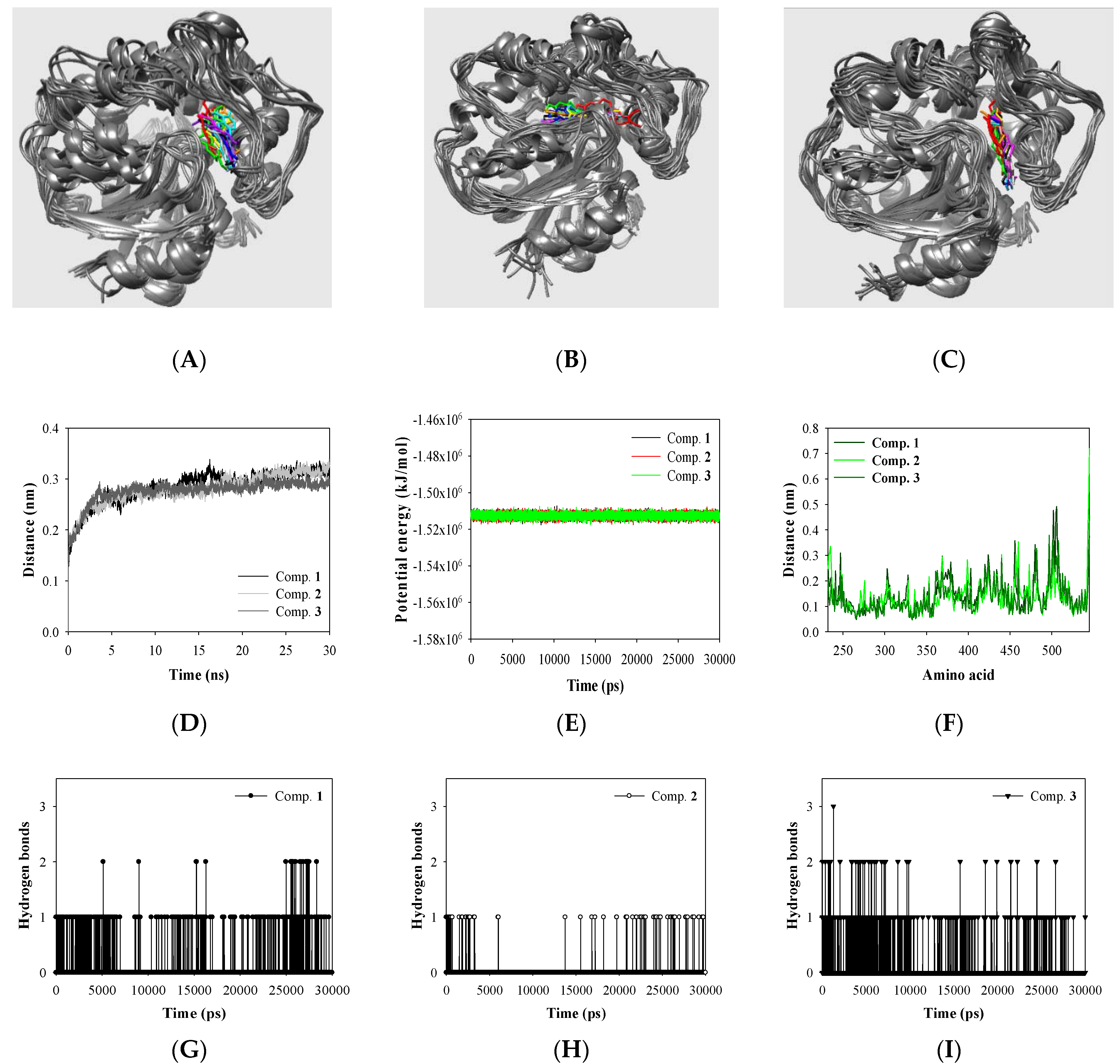Inhibitory Activity of Quaternary Isoquinoline Alkaloids on Soluble Epoxide Hydrolase
Abstract
1. Introduction
2. Materials and Methods
2.1. General Experimental Procedures
2.2. sEH Enzymatic Assay
2.3. Molecular Docking
2.4. Molecular Dynamics
3. Results
3.1. Inhibition Effect of the Quaternary Isoquinoline Alkaloids on sEH
3.2. Enzyme Kinetics
3.3. Molecular Docking Study
3.4. Molecular Dynamics Study
4. Discussion
5. Conclusions
Author Contributions
Funding
Institutional Review Board Statement
Informed Consent Statement
Data Availability Statement
Conflicts of Interest
References
- Imig, J.D.; Hammock, B.D. Soluble epoxide hydrolase as a therapeutic target for cardiocascular disease. Nature 2009, 8, 794–805. [Google Scholar]
- Falck, J.R.; Reddy, L.M.; Reddy, Y.K.; Bondlela, M.; Krishna, Y.M.; Ji, Y.; Sun, J.; Liao, J.K. 11,12-epoxyeicosatrienoic acid (11,12-EET): Structural determinants for inhibition of TNF-α-induced VCAM-1 expression. Bioorg. Med. Chem. Lett. 2003, 13, 4011–4014. [Google Scholar] [CrossRef] [PubMed]
- Sun, C.-P.; Zhang, X.-Y.; Morisseau, C.; Hwang, S.H.; Zhang, Z.-J.; Hammock, B.D.; Ma, X.-C. Discovery of soluble epoxide hydrolase inhibitor from chemical synthesis and natural products. J. Med. Chem. 2021, 64, 184–215. [Google Scholar] [CrossRef] [PubMed]
- Kim, J.; Imig, J.D.; Yang, J.; Hammock, B.D.; Padanilam, B.J. Inhibition of soluble epoxide hydrolase prevents renal interstitial fibrosis and inflammation. Am. J. Physiol. Physiol. 2014, 307, 971–980. [Google Scholar] [CrossRef] [PubMed]
- Schmelzer, K.R.; Kubala, L.; Newman, J.W.; Kim, I.-H.L.; Eiserich, J.P.; Hammock, B.D. Soluble epoxide hydrolase is a therapeutic target for acute inflammation. Proc. Natl. Acad. Sci. USA 2005, 102, 9772–9777. [Google Scholar] [CrossRef]
- Gao, L.; Kong, X.; Wu, W.; Feng, Z.; Zhi, H.; Zhang, Z.; Long, H.; Lei, M.; Hou, J.; Wu, W.; et al. Dissecting the Regulation of Arachidonic Acid Metabolites by Uncaria rhynchophylla (Miq). Miq. In Spontaneously Hypertensive Rats and the Predictive Target sEH in the Anti-Hypertensive Effect Based on Metabolomics and Molecular Docking. Front. Pharmacol. 2022, 23, 909631. [Google Scholar] [CrossRef]
- Manickam, M.; Meenakshisundaram, S.; Pillaiyar, T. Activating endogenous resolution pathways by soluble epoxide hydrolase inhibitors for the management of COVID-19. Arch. Pharm. 2022, 355, e2100367. [Google Scholar] [CrossRef]
- Hammock, B.D.; Wang, W.; Gilligan, M.M.; Panigrahy, D. Eicosanoids the overlooked strom in coronavirus Disease 2019(COVID-19)? Am. J. Pathol. 2020, 190, 1782–1787. [Google Scholar] [CrossRef]
- Wangner, K.M.; McReynolds, C.B.; Schmidt, W.K.; Hammock, B.D. Soluble epoxide hydrolase as a therapeutic target for pain, inflammatory and neurodegenerative diseases. Pharmacol. Ther. 2017, 180, 62–76. [Google Scholar] [CrossRef]
- Lee, K.S.S.; Ng, C.; Yang, J.; Hwang, S.-H.; Morisseau, C.; Wagner, K.; Hammock, B.D. Preparation and evaluation of soluble epoxide hydrolase inhibitors with improved physical properties and potencies for treating diabetic neuropathic pain. Bioorg. Med. Chem. 2020, 28, 115735. [Google Scholar] [CrossRef]
- Hammock, B.D.; McReynolds, C.B.; Wagner, K.; Alan, B.; Cortes-Puch, I.; Croston, G.; Lee, K.S.S.; Yang, J.; Schmidt, W.K.; Hwang, S.H. Movement to the clinic of soluble epoxide hydrolase inhibitor EC5026 as an analgesic for neuropathic pain and for use as a nonaddctive opioid alternative. J. Med. Chem. 2021, 64, 1856–1872. [Google Scholar] [CrossRef] [PubMed]
- Zhao, W.-Y.; Zhang, X.-Y.; Zhou, M.-R.; Tian, X.-G.; Lv, X.; Zhang, H.-L.; Deng, S.; Zhang, B.-J.; Sun, C.-P.; Ma, X.-C. Natural soluble epoxide hydrolase inhibitors from Alisma orientale and their potential mechanism with soluble epoxide hydrolase. Inter. J. Biol. Macromol. 2021, 183, 811–817. [Google Scholar] [CrossRef] [PubMed]
- Kim, J.H.; Jo, Y.D.; Kim, H.-Y.; Kim, B.-R.; Nam, B. In vitro and in silico insights into sEH inhibitors with Amide-Scaffold from the leaves of Capsicum chinense Jacq. Comput. Struct. Biotechnol. J. 2018, 16, 404–411. [Google Scholar] [CrossRef] [PubMed]
- Abd Ei-Aziz, N.M.; Khalifa, I.; Darwish, A.M.G.; Badr, A.N.; Aljumayi, H.; Hafez, E.-S.; Shehata, M.G. Docking analysis of some bioactive compounds from traditional plants against SARS-CoV-2 target proteins. Molecules 2022, 27, 2662. [Google Scholar] [CrossRef]
- Sun, C.-P.; Zhang, J.; Zhao, W.-Y.; Yi, J.; Yan, J.-K.; Wang, Y.-L.; Morisseau, C.; Liu, Z.-B.; Hammock, B.D.; Ma, X.-C. Protostane-type trierpenoids as natural soluble epoxide hydrolase inhibitors: Inhibition potential and molecular dynamics. Bioorg. Chem. 2020, 96, 103637. [Google Scholar] [CrossRef] [PubMed]
- Liu, J.-Y.; Morisseau, C.; Huang, H.; Hammock, B.D. Screening of soluble epoxide hydrolase inhibitory ingredients from traditional Chinese medicines for anti-inflammatory use. J. Ethnopharmacol. 2016, 194, 475–482. [Google Scholar] [CrossRef]
- Lv, X.; Li, Y.; Tang, C.; Zhang, Y.; Zhang, J.; Fan, G. Integration of HPLC-based fingerprint and quatitiative analyses for differentiating botanical species and geographical growing origins of Rhizoma Coptidis. Pharm. Biol. 2016, 54, 3264–3271. [Google Scholar] [CrossRef]
- Ma, Z.; Zhu, L.; Wang, S.; Guo, X.; Sun, B.; Wang, Q.; Chen, L. Berberine protects diabetic nephropathy by suppressing epithelial-to-mesenchymal transition involving the inactivation of the NLRP3 inflammasome. Ren. Fail. 2022, 44, 923–932. [Google Scholar] [CrossRef]
- Kim, J.H.; Jin, C.H. Inhibitory Activity of Flavonoids, Chrysoeriol and Luteolin-7-O-Glucopyranoside, on Soluble Epoxide Hydrolase from Capsicum chinense. Biomolecules 2020, 10, 180. [Google Scholar] [CrossRef]
- Kim, J.H.; Thao, N.P.; Han, Y.K.; Lee, Y.S.; Luyen, B.T.T.; Oanh, H.V.; Kim, Y.H.; Yang, S.Y. The insight of in vitro and in silico studies on cholinesterase inhibitors from the roots of Cimicifuga dahurica (Turcz.) Maxim. J. Enzym. Inhib. Med. Chem. 2018, 33, 1174–1180. [Google Scholar] [CrossRef]
- Stermitz, F.R.; Lorenz, P.; Tawara, J.N.; Lewis, K. Synergy in a medicinal plant: Antimicrobial action of berberine potentiated by 5′-methoxyhydnocarpin, a multidrug pump inhibitor. Proc. Natl. Acad. Sci. USA 2000, 97, 1433–1437. [Google Scholar] [CrossRef] [PubMed]
- Xu, Y.; Sun, J.; Li, W.; Zhang, S.; Yang, L.; Teng, Y.; Lv, K.; Liu, Y.; Su, Y.; Zhang, J.; et al. An Analgesic effect of the main components of Corydalis yanhusuo (yanhusuo in Chinese) is caused by inhibition of voltage gated sodium channels. J. Ethnopharmacol. 2021, 280, 114457. [Google Scholar] [CrossRef] [PubMed]
- Neag, M.A.; Mocan, A.; Echeverría, J.; Pop, R.M.; Bocsan, C.I.; Crişan, G.; Buzoianu, A.D. Berberine: Botanical occurrence, traditional uses, extraction methods, and relevance in cardiovascular, metabolic, hepatic, and renal disorders. Front. Pharmacol. 2018, 9, 557. [Google Scholar] [CrossRef]
- Tian, Y.; Li, S.; Dong, K.; Su, X.; Fu, S.; Lv, X.; Duan, M.; Yang, T.; Han, Y.; Hu, G.; et al. Discovery of benzamide derivatives containing urea moiety as soluble epoxide hydrolase inhibitors. Bioorg. Chem. 2022, 127, 105898. [Google Scholar] [CrossRef]
- He, X.; Zhao, W.-Y.; Shao, B.; Zhang, B.-J.; Liu, T.-T.; Sun, C.-P.; Huang, H.-L.; Wu, J.-R.; Liang, L.-H.; Ma, X.-C. Natural soluble epoxide hydrolase inhibitors from Inula helenium and their interactions with soluble epoxide hydrolase. Inter. J. Biol. Macromol. 2020, 158, 1362–1368. [Google Scholar] [CrossRef] [PubMed]





| Compound | Inhibition of Compounds on sEH a | |
|---|---|---|
| IC50 (μM) | Binding Mode (ki, M) | |
| 1 | 29.6 ± 0.5 | Non-competitive(26.9) |
| 2 | 33.4 ± 0.8 | Non-competitive(46.8) |
| 3 | 27.3 ± 0.4 | Non-competitive(44.5) |
| AUDA b | 4.0 ± 1.3 nM | |
| Autodock Score (kcal/mol) | Hydrogen Bonds (Å) | |
|---|---|---|
| 1 | −8.96 | Phe497(3.03), His524 (2.79) |
| 2 | −9.14 | Tyr383 (2.98) |
| 3 | −8.82 | Lys495 (2.81), His524 (2.79) |
Publisher’s Note: MDPI stays neutral with regard to jurisdictional claims in published maps and institutional affiliations. |
© 2022 by the authors. Licensee MDPI, Basel, Switzerland. This article is an open access article distributed under the terms and conditions of the Creative Commons Attribution (CC BY) license (https://creativecommons.org/licenses/by/4.0/).
Share and Cite
Kim, J.H.; Cho, C.W.; Hur, M.; Park, W.T.; Moon, Y.-H.; Koo, S.-C.; Hur, Y.-C.; Kang, J.S.; Lee, I.S. Inhibitory Activity of Quaternary Isoquinoline Alkaloids on Soluble Epoxide Hydrolase. Curr. Issues Mol. Biol. 2022, 44, 4282-4289. https://doi.org/10.3390/cimb44090294
Kim JH, Cho CW, Hur M, Park WT, Moon Y-H, Koo S-C, Hur Y-C, Kang JS, Lee IS. Inhibitory Activity of Quaternary Isoquinoline Alkaloids on Soluble Epoxide Hydrolase. Current Issues in Molecular Biology. 2022; 44(9):4282-4289. https://doi.org/10.3390/cimb44090294
Chicago/Turabian StyleKim, Jang Hoon, Chong Woon Cho, Mok Hur, Woo Tae Park, Youn-Ho Moon, Sung-Cheol Koo, Yun-Chan Hur, Jong Seong Kang, and Ik Soo Lee. 2022. "Inhibitory Activity of Quaternary Isoquinoline Alkaloids on Soluble Epoxide Hydrolase" Current Issues in Molecular Biology 44, no. 9: 4282-4289. https://doi.org/10.3390/cimb44090294
APA StyleKim, J. H., Cho, C. W., Hur, M., Park, W. T., Moon, Y.-H., Koo, S.-C., Hur, Y.-C., Kang, J. S., & Lee, I. S. (2022). Inhibitory Activity of Quaternary Isoquinoline Alkaloids on Soluble Epoxide Hydrolase. Current Issues in Molecular Biology, 44(9), 4282-4289. https://doi.org/10.3390/cimb44090294


_Kim.png)




